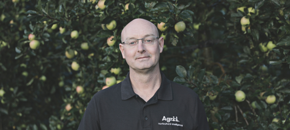Feeding the Roots
Phosphorus for Profitable Crops
The Value of Phosphorus: Insights for UK Farmers from Tramlines Podcast
Phosphorus is one of the most important nutrients for UK crops, from cereals to potatoes and vegetables. It underpins establishment, root growth, and energy functions, yet long-term data suggests usage is declining and crop demand may be outstripping supply.
In a recent episode of Tramlines, Agrii’s podcast for UK agriculture, host Tony Smith was joined by:
- Tom Land, Fertiliser Technical Manager (Agrii)
- Don Pendergrast, Technical Manager for Specialty Crops (Agrii)
Together, they discussed phosphorus’ role in crop health, the latest research and technologies, and how growers can make the best return on investment.
This Episode Features:

Tony Smith
Your Tramlines Host

Tom Land
National Fertiliser Manager

Don Pendergrast
Technical Manager - Non-Combinable Trials
Why is phosphorus so important?
What does phosphorus actually do for cereals?
Tom: It supports establishment and root development, and it powers energy transfer inside the plant. The net result is quicker growth, better fertility and stronger yield potential.
What about potatoes and veg?
Don: It is just as critical. In potatoes, available P influences tuber initiation and starch storage. In veg crops, it underpins rooting and the development of storage organs. If P is short, crops rarely hit their ceiling. Without enough phosphorus, plants simply do not reach their potential.
Are farmers applying enough?
Fertiliser use has fallen. Is that an issue?
Tom: Efficiency has improved, but long-term grain analysis shows P levels are slipping. That suggests crop demand can outpace supply. Soil tests matter, yet a grain test at harvest reveals whether P or N limited the crop in reality.
Did you know?
A grain test can quickly show if phosphorus was limiting yield.
What does the latest research say?
What is new in improving P use efficiency?
Tom: We are evaluating a suite of approaches:
- Release® to unlock bound P in soil.
- Coated fertilisers that keep P available and reduce lock-up.
- Microgranules and liquid P for accurate placement at drilling.
Glasshouse work shows these methods can increase root mass, which supports better nutrient uptake.
How does this translate to potatoes and specialty crops?
Don: Precision placement near the root zone at planting pays. We also combine P strategies with biostimulants and look at carbon reduction while keeping nutrition optimised. Precision placement is especially important in potatoes. Get P to the roots quickly.
How should I decide where to spend?
Is throwing everything at the crop ever worthwhile?
Tom: Our “kitchen sink” trials stacked cost without proportional return. A medium input strategy was consistently the most profitable. Focus on ROI rather than headline yield.
What is the key timing in potatoes?
Don: Early work wins. What you do in the seedbed and up to tuber initiation sets potential. Later inputs rarely match the payback.
Did you know?
Agrii trials found medium input strategies balance output and margin best. Adding extras indiscriminately can reduce profitability.
What are the practical next steps?
How do I check what my crops really need?
Tom:
- Run soil tests for P, K, Mg and pH.
- Add a grain test at harvest to confirm uptake and limitations.
- Match P strategy to soil type, pH and crop demand.
Any potato-specific pointers?
Don: Use precision placement so roots access P fast. Work with your agronomist to tailor nutrition and cost to your system.
Where can I learn more?
Tom: Speak with your Agrii agronomist, check live results on our website and follow our updates. Join our open days for local insight.
Don: The Potato Partnership runs open events through the season and publishes results, with key updates each February.
Top tips
- Tom: Run a grain test. It is low cost and gives clear feedback on P use.
- Don: Seedbed decisions set yield potential. Prioritise early establishment.
If you have a question for our experts, email info@agrii.co.uk.
Related episodes
The Ripening Story of British Blackcurrants in a Changing Climate
Episode 8Rooted in Nutrition: Soil Health and Smarter Inputs
Episode 4Seed Success: Understanding Treatments, Science & Innovation
Episode 20The Reality of SFI: Part 2 - The What, Where and How?
Episode 19Smart Nutrition: Maximising ROI on Phosphate, Potash & Nitrogen
Episode 18Carbon Trading - The Reality
Episode 12Integrated Pest Management and Beneficial Insects
Episode 11Focusing on Phosphate with Agrii's Nutrition Specialists
Episode 9Branching Out With Top Fruit Nutrition
Episode 8Never miss an episode of Tramlines








